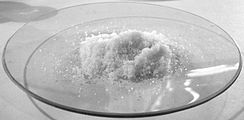
Back Ammoniumkarbonaat Afrikaans كربونات الأمونيوم Arabic Ammonium karbonat Azerbaijani آمونیوم کربونات AZB Амониев карбонат Bulgarian অ্যামোনিয়াম কার্বনেট Bengali/Bangla Uhličitan amonný Czech Ammoniumcarbonat German Amonia karbonato Esperanto Carbonato de amonio Spanish
 | |
 | |
 | |
| Names | |
|---|---|
| IUPAC name
Ammonium carbonate
| |
Other names
| |
| Identifiers | |
| |
3D model (JSmol)
|
|
| ChEBI | |
| ChemSpider | |
| ECHA InfoCard | 100.007.326 |
| EC Number |
|
| E number | E503(i) (acidity regulators, ...) |
PubChem CID
|
|
| UNII | |
| UN number | 3077 |
CompTox Dashboard (EPA)
|
|
| |
| |
| Properties | |
| [NH4]2CO3 | |
| Molar mass | 96.086 g·mol−1 |
| Appearance | White powder |
| Density | 1.50 g/cm3 |
| Melting point | 58 °C (136 °F; 331 K) (decomposes) |
| 100 g/(100 ml) (15°C)[1] 25 g/(100 ml) (20°C) | |
| −42.50·10−6 cm3/mol | |
| Hazards | |
| Occupational safety and health (OHS/OSH): | |
Main hazards
|
Irritant |
| GHS labelling: | |

| |
| Warning | |
| H302, H319 | |
| Safety data sheet (SDS) | External MSDS |
| Related compounds | |
Other anions
|
Ammonium bicarbonate Ammonium carbamate |
Other cations
|
Sodium carbonate Potassium carbonate |
Except where otherwise noted, data are given for materials in their standard state (at 25 °C [77 °F], 100 kPa).
| |
Ammonium carbonate is a chemical compound with the chemical formula [NH4]2CO3. It is an ammonium salt of carbonic acid. It is composed of ammonium cations [NH4]+ and carbonate anions CO2−3. Since ammonium carbonate readily degrades to gaseous ammonia and carbon dioxide upon heating, it is used as a leavening agent and also as smelling salt. It is also known as baker's ammonia and is a predecessor to the more modern leavening agents baking soda and baking powder. It is a component of what was formerly known as sal volatile and salt of hartshorn,[2] and produces a pungent smell when baked. It comes in the form of a white powder or block, with a molar mass of 96.09 g/mol and a density of 1.50 g/cm3. It is a strong electrolyte.
- ^ John Rumble (June 18, 2018). CRC Handbook of Chemistry and Physics (99th ed.). CRC Press. pp. 4–40. ISBN 978-1138561632.
- ^ Cite error: The named reference
Ullmannwas invoked but never defined (see the help page).